
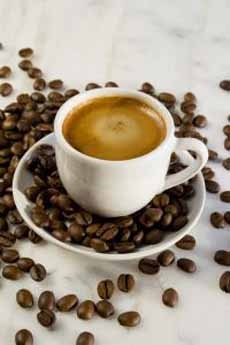 Espresso is made with dark roasted beans (photo by FlavioTakemoto | SXC | Free Images). Espresso is made with dark roasted beans (photo by FlavioTakemoto | SXC | Free Images).
July 2005
Last Updated September 2025
|
 |
Types Of Coffee
Page 6: Coffee Terms & Definitions R To Z
Do you know the different types of coffee? Study these terms and you’ll have a much greater appreciation of your next sip of coffee. Practice the language of coffee by using these terms to describe each cup you drink. Soon, they’ll become natural to you, and you’ll be able to educate others. This is Page 6 of a six-page Coffee Glossary. For terms specific to espresso, see our separate Espresso Glossary. We have many more food glossaries, covering your other favorite foods.
Click on a letter to go to the appropriate glossary section:
a b c d e f g h i j k l m n o p q r s t u v w x y z
This glossary is protected by copyright and cannot be reproduced in whole or in part.
You are welcome to link to it.
RANCID
Since coffee beans are high in fats, the fats can go rancid, like any other oil. They will smell rancid.
RICH
Coffee with depth and complexity of flavor, full body, and an overall satisfying taste.
RIO
An iodine aroma or flavor is caused by a bacterium that attacks the coffee. It used to be prevalent in coffees from Brazil, hence the descriptor.
ROASTING & ROASTS
The application of heat is applied to green coffee beans for the purpose of developing certain flavor characteristics: the darker the roast, the heavier the flavor. In order, the degrees of roasts recognized by the National Coffee Association are:
- Light Roasts: Light City, Half City, Cinnamon, New England
Light brown in color, these varieties have not been roasted long enough for the oils to break through to the surface.
- Medium Roasts: City, American, Breakfast
Medium brown in color and stronger flavor than Light Roasts, these beans also have a non-oily surface. This is the roast preferred in the United States.
- Medium/Dark Roast: Full City
Darker in color than medium roasts and richer in flavor, these beans have some oil on the surface and create a brew with a slight, bittersweet aftertaste.
- Dark Roasts: High, Continental, New Orleans, European, Espresso,
Viennese, Italian, French
These slightly dark to charred-black beans have a shiny, oily surface and create coffee—the darker the roast, the oilier the bean (long roasting brings the internal oils to the surface). They produce coffee with a pronounced bitterness, but the darker the roast, the less acidity it has.
ROASTY
A bittersweet, smoky flavor that’s emitted by a dark roast.
ROBUSTA
Coffea robusta typically grows in hotter and more humid areas at lower altitudes, around 600 to 1500 feet. It produces a coffee that has less fine, less nuanced qualities than Coffea arabica, grown at higher altitudes. It also has more caffeine than arabica.
ROUGH
Characterized by a parched, dry sensation on the tongue, related to sharp, salty taste sensations. Usually, it’s the result of lower-grown coffee.
RUBBERY
The aroma and flavor of hot rubber tires or rubber bands, a characteristic of bad robusta coffee.
|
SALTED COFFEE or VIETNAMESE SALTED COFFEE
Called ca phe muoi in Vietnamese, this brew is even thicker than Vietnamese egg coffee. The top, which looks like it might be marshmallow creme, is actually made from heavy cream, sugar, and salt. The result is a luscious sweet-and-salty drink with a base of Vietnamese coffee.
It was created as a small, unassuming coffee shop in the ancient capital of Hue.
Instead of heavy cream, some recipes use sweetened condensed milk instead of heavy cream and sugar, and top the glass with salted cream.
The Vietnamese name is pronounced kah fay MOY, with a rising tone on the last syllable.
|
|
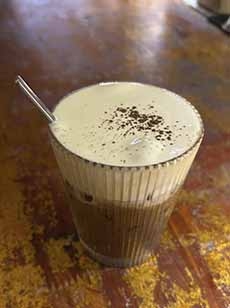
Vietnamese salted coffee (photo © Flavor & The Menu). |
|
SHADE-GROWN COFFEE
This coffee is grown under shady tree canopies in the rainforest. Coffee has traditionally been grown this way. More recently, large producers have been eliminating rainforest trees and growing coffee under the full sun. Shade-grown coffee implies organic or other ecologically sensitive growing conditions.
SMOOTH
Coffee that is low in acidity with smooth edges and a pleasant mouthfeel.
|
|
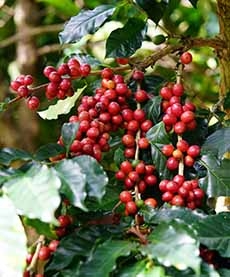
Shade coffee (photo © 1500m Coffee | Pexels). |
SOFT
Low-acid, mild-flavored coffee.
SOFT BEAN
Beans grown at relatively low altitudes mature more quickly and produce a lighter, more porous, less dense bean.
SOUR
A puckery, astringent taste that is drying in the mouth due to poor coffee processing.
SPARKLING
Bright acidity that dances on the tongue before quickly dissipating—the coffee version of Champagne bubbles.
SPICY
An aromatic and taste perception reminiscent of either wood-spice (cinnamon) or wood-seed (clove). Aged coffees are often spicy.
STALE
Coffee that is flat with a cardboard taste due to being exposed to oxygen for too long. See Flat.
STRAW
A negative quality, generally before the coffee turns woody. See also past crop and woody.
STEWED
The flavor of reheated coffee.
STRENGTH
The ratio of ground coffee to water.
SUPREMO
The highest grade of coffee. The second-best grade is Extra.
SWEET
A coffee that is smooth, tasty, and free from harshness.
SYRUPY
A thick-bodied coffee with a substantial aftertaste.
TANGY
Lingering acidity.
THIN
No acidity, a lifeless flavor due to underbrewing.
TONE
The appearance or color of coffee.
|
TAHINI COFFEE
Tahini coffee was popularized in 2025 by a New York City bakery-café chain, Maman. Maman’s Salted Tahini Honeycomb Latte went viral and inspired many copycat recipes.
Simpler recipes also evolved. Find ours here, along with more about tahini coffee.
Tahini adds nutty flavor as well as protein to a cup of coffee or espresso. The protein from the tahini turns the coffee into a functional or nutrient-dense food, in the manner of other enhanced coffee drinks like bulletproof coffee‡, turmeric lattes, and other enhanced coffee drinks.
|
|
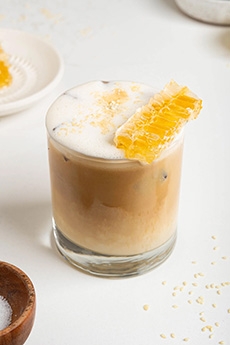
The original Salted Tahini Honeycomb Coffee. Here’s the recipe (photo © Salima’s Kitchen). |
|
TURKISH COFFEE
A strong, sugared, silty beverage made from coffee ground extra-fine into a powder almost the consistency of flour. It is made with an equal ratio of coffee and sugar in a special pot called an ibriq, boiled and removed from the heat 3 times to achieve a thick beverage with a distinctive taste that is served with the grounds. This method is the same as that used to make Greek coffee. When coffee traveled north to Austria, the Viennese invented the process of filtering coffee.
VARIETAL
A single or straight coffee from one region or country of origin.
|
|
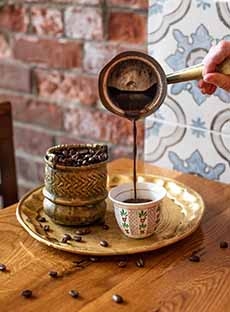
Turkish coffee (photo © Miriam’s | NYC). |
VIENNESE COFFEE
Coffee incorporating semisweet chocolate and heavy cream, beaten until frothy, and topped with whipped cream. It can be spiced with cloves and cinnamon.
VIENNA or VIENNESE ROAST
A roast slightly darker than an American Roast. Some of the chestnut-colored beans have oil on the surface, and some are dry. The sugar in the beans is caramelized, and the flavor is balanced in terms of acidity, aroma, body, and varietal flavor characteristics.
WHOLE BEAN
Coffee that has been roasted but not ground.
WILD
Exotic-flavored coffees with extreme characteristics.
WINEY or WINY
A term used to describe some coffees that are full-bodied, smooth yet lively, similar to a mature red wine.
WOODY
The aroma and flavor of wood—think old pine or plywood—and a very dry mouthfeel. It’s generally a negative quality of old coffee—see past crop—although some coffees, e.g., from Yemen and Sumatra, have a touch of woodiness as part of their natural flavor profile.
Return To Article Index Above
Lifestyle Direct, Inc. All rights reserved. Images are the copyright of their respective owners.

|








